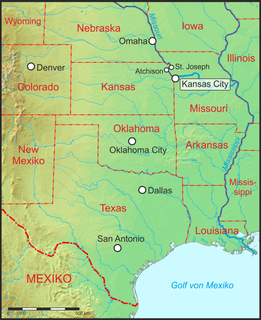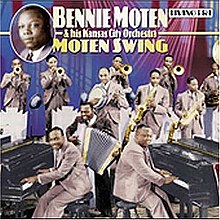
A big band is a type of musical ensemble of jazz music that usually consists of ten or more musicians with four sections: saxophones, trumpets, trombones, and a rhythm section. Big bands originated during the early 1910s and dominated jazz in the early 1940s when swing was most popular. The term "big band" is also used to describe a genre of music, although this was not the only style of music played by big bands.

William James "Count" Basie was an American jazz pianist, organist, bandleader, and composer. In 1935, Basie formed his own jazz orchestra, the Count Basie Orchestra, and in 1936 took them to Chicago for a long engagement and their first recording. He led the group for almost 50 years, creating innovations like the use of two "split" tenor saxophones, emphasizing the rhythm section, riffing with a big band, using arrangers to broaden their sound, and others. Many musicians came to prominence under his direction, including the tenor saxophonists Lester Young and Herschel Evans, the guitarist Freddie Green, trumpeters Buck Clayton and Harry "Sweets" Edison, plunger trombonist Al Grey, and singers Jimmy Rushing, Helen Humes, Thelma Carpenter, and Joe Williams.
Swing music is a form of jazz that developed in the United States in the 1930s and 1940s. The name came from the emphasis on the off–beat, or weaker pulse. Swing bands usually featured soloists who would improvise on the melody over the arrangement. The danceable swing style of big bands and bandleaders such as Benny Goodman was the dominant form of American popular music from 1935 to 1946, known as the swing era. The verb "to swing" is also used as a term of praise for playing that has a strong groove or drive. Notable musicians of the swing era include Duke Ellington, Benny Goodman, Louis Armstrong(Dixieland jazz), Count Basie, Cab Calloway, Jimmy Dorsey, Tommy Dorsey, Woody Herman, Harry James, Lionel Hampton, Glenn Miller, and Artie Shaw.

James Andrew Rushing was an American blues and jazz singer, and pianist from Oklahoma City, Oklahoma, best known as the featured vocalist of Count Basie's Orchestra from 1935 to 1948.
The swing era was the period (1933–1947) when big band swing music was the most popular music in the United States. Though this was its most popular period, the music had actually been around since the late 1920s and early 1930s, being played by black bands led by such artists as Duke Ellington, Jimmie Lunceford, Bennie Moten, Cab Calloway, Earl Hines, and Fletcher Henderson, and white bands from the 1920s led by the likes of Jean Goldkette, Russ Morgan and Isham Jones. An early milestone in the era was from "the King of Swing" Benny Goodman's performance at the Palomar Ballroom in Los Angeles on August 21, 1935, bringing the music to the rest of the country. The 1930s also became the era of other great soloists: the tenor saxophonists Coleman Hawkins, Ben Webster and Lester Young; the alto saxophonists Benny Carter and Johnny Hodges; the drummers Chick Webb, Gene Krupa, Jo Jones and Sid Catlett; the pianists Fats Waller and Teddy Wilson; the trumpeters Louis Armstrong, Roy Eldridge, Bunny Berigan, and Rex Stewart.

Oran Thaddeus "Hot Lips" Page was an American jazz trumpeter, singer, and bandleader. He was known as a scorching soloist and powerful vocalist.
Charles Phillip Thompson was an American swing and bebop pianist, organist, composer, and arranger.

Benjamin "Bennie" Moten was an American jazz pianist and band leader born and raised in Kansas City, Missouri.

The Count Basie Orchestra is a 16 to 18 piece big band, one of the most prominent jazz performing groups of the swing era, founded by Count Basie in 1935 and recording regularly from 1936. Despite a brief disbandment at the beginning of the 1950s, the band survived long past the Big Band era itself and the death of Basie in 1984. It continues as a 'ghost band'.
Walter Sylvester Page was an American jazz multi-instrumentalist and bandleader, best known for his groundbreaking work as a double bass player with Walter Page's Blue Devils and the Count Basie Orchestra.
The Oklahoma City Blue Devils was the premier American Southwest territory jazz band in the 1920s. Originally called Billy King's Road Show, it disbanded in Oklahoma City in 1925 where Walter Page renamed it. The name Blue Devils came from the name of a gang of fence cutters operating during the early days of the American West.

Kansas City jazz is a style of jazz that developed in Kansas City, Missouri during the 1920s and 1930s, which marked the transition from the structured big band style to the musical improvisation style of Bebop. The hard-swinging, bluesy transition style is bracketed by Count Basie who in 1929 signed with the Bennie Moten's Kansas City Orchestra and Kansas City native Charlie Parker who ushered in the Bebop style in America. "While New Orleans was the birthplace of jazz, America's music grew up in Kansas City". Kansas City is known as one of the most popular "cradles of jazz". Other cities include New Orleans, Chicago, St. Louis, Pittsburgh, Philadelphia, and New York City. Kansas City was known for the organized musicians of the Local 627 A.F.M., which controlled a number of venues in the city.
"Kansas City Shuffle" is the name of a 1926 jazz song.
Albert J. "Budd" Johnson III was an American jazz saxophonist and clarinetist who worked extensively with, among others, Ben Webster, Benny Goodman, Big Joe Turner, Coleman Hawkins, Dizzy Gillespie, Duke Ellington, Quincy Jones, Count Basie, Billie Holiday and, especially, Earl Hines.

Herschel "Tex" Evans was an American tenor saxophonist who worked in the Count Basie Orchestra. He also worked with Lionel Hampton and Buck Clayton. He is also known for starting his cousin Joe McQueen's interest in the saxophone.
Eddie Durham was an American jazz guitarist who was one of the pioneers of the electric guitar in jazz. He was a guitarist, trombonist, composer, and arranger for the orchestras of Bennie Moten, Jimmie Lunceford, and Count Basie.
Ed Lewis was an American jazz trumpeter.
Ronald "Jack" Washington was an American jazz saxophonist who was a member of the Count Basie orchestra in the 1930s and 1940s.
Thamon Hayes was a Dixieland jazz trombonist and composer of the early Kansas City jazz scene, who along with Bennie Moten composed several of the hits of the Bennie Moten's Kansas City Orchestra such as "South" and the original 1927 version of "Moten Swing". He left the band in 1931 to form the Kansas City Rockets, which in 1936 became "Leonard's Rockets". Hayes´ new band were billed by the Kansas City Call as "the new wonder band of accomplished musicians", and their first performance was met with unprecedented attention in Kansas City driving the crowds wild.
The Pearl Theatre was a theatre in Philadelphia. Opened in 1927 with 1400 seats, it was a notable jazz and dance venue and had a glamorous reputation among the rich and famous. In 1931, the Nicholas Brothers played here. Duke Ellington, John Coltrane, and many other prominent jazz ensembles of the period performed here. Bennie Moten and the Kansas City Stompers's featuring Count Basie on piano performed at the club in November 1931, and in December 1932 the audience raved all week about their "Moten Swing"; the doors of the theatre were let open to the public who came crammed into the theatre to hear the new sound, demanding seven encores on one night. Pearl Bailey was discovered at the theatre, where she entered and won the theatre's amateur song and dance contest and was to be paid $35 a week to perform there for two weeks, however, the theatre closed during her engagement and she was never paid.








